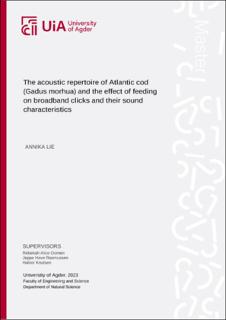The acoustic repertoire of Atlantic cod (Gadus morhua) and the effect of feeding on broadband clicks and their sound characteristics
Abstract
Populations of Atlantic cod (Gadus morhua) along the Skagerrak coast remain below viable levels today despite various implemented management strategies aimed at their recovery. Augmented management approaches are needed to reverse the population decline and secure sustainable harvesting. Bioacoustical studies such as passive acoustic monitoring, could potentially enhance our understanding of cod behaviour and assist identifying crucial coastal habitats during vulnerable stages of cod development. Additionally, it may be applied in sustainable food production, such as cod aquaculture. However, such automated monitoring systems require baseline studies to increase our known acoustic repertoire of cod sound production. Additionally, a reference library of annotated cod sounds is needed for training deep learning algorithms. Less attention has been given to high frequency broadband clicks emerging from cod. We do not yet understand their behavioural context, let alone their underlying biomechanics. Previously, clicks have only been observed when cod has been threatened or approached by a predator-like figure. Clicks were therefore related to agonistic behaviour and suggested to have a predator starling function.
This study aimed to 1) Catalogue all cod sounds to produce an annotated reference library for future training of a deep learning algorithm 2) Characterise acoustic variation in cod clicks, and 3) Investigate how clicks relate to behaviour by testing the effects of feeding on click count and sound characteristics. The study was conducted during the spawning season in an isolated semi-natural basin in Southern Norway. Sounds from 45 adult cod were manually analysed and annotated from 36 hours of recorded material. This is the first time that all known cod sounds are observed and described in the same study. Knocks, grunts, hums and rumblings were observed in addition to high frequency broadband clicks. Clicks were the second most occurring sound from cod in the recordings, suggesting that clicks are an important part of cod sound production. Contrary to previous reports, the study observed continuous variation in click characteristics rather than discrete categories of click types. The study found that cod clicks occur independent of disturbance and that feeding did not influence the sound characteristics, suggesting that clicks could have an extended function than previously assumed. The study expands our knowledge on the repertoire of cod acoustics and assists in the development of new technology for acoustic monitoring. Further, it advances our understanding of the role of clicking in cod behaviour and ecology.
